Learning from Other Gardens
Posted on Tuesday, June 6, 2023 · Leave a Comment
One of the best ways to learn how to create a lovely garden is to see others. Visit good gardens of neighbors, great gardens near and far. I recently visited three great gardens and, as always when viewing other gardens, they gave me much to consider. The gardens I visited were Bed Rock Gardens in Lee, NH, Chanticleer Gardens in Wayne, PA and Longwood Gardens in Kennett Square, PA.
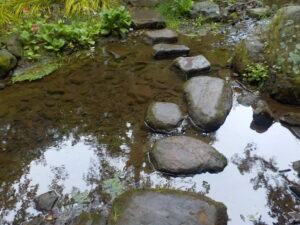
Path crossing water at Chanticleer
All these gardens had significant areas of lawn or meadow. I realize that lawns are not in favor, generally, among the pro-pollinator and bird crowd. But if you provide plenty of plants that support pollinators, I do not see lawns as bad. Each of these gardens has plenty of flowering trees, shrubs, perennials and annuals. Something is always in bloom, including both native plants and exotic ones.
So what does lawn accomplish? It provides contrast – a simple green palette – to show off the plants. Expanses of green are soothing to the eye. I can only focus on so many amazing plants before I get visually fatigued – much as I do when I visit an art museum.
Lawn also allows you to stand back to see the landscape from a distance. For trees, that is important. In a forested area, and all three of these gardens have them, individual trees are sometimes hard to see. They blend in with the others. But I need to stand back to look at a majestic beech or oak that towers 100 feet above me.
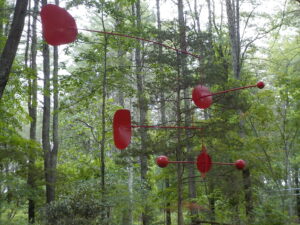
Sculpture in the woods at Bedrock Gardens
Bedrock Garden only recently was deeded over from the original owners, Jill Nooney and Bob Munger, to the non-profit that manages the property. Jill is an amazing sculptor who for over 30 years has created art to surprise and delight visitors to this 20 acre garden. Much of her art is painted welded steel that will delight visitors for the century ahead. She is the modern Alexander Calder of gardens.
Although I am not an artist, I do purchase and create art and whimsy for my own gardens, and you can, too. Look around at what you can use: a brass headboard from an abandoned bed; the rim of an old wagon wheel, a collection of stacked stones or a single tall standing stone buried in the ground. Stone always enhances a garden. Walls are expensive, but almost worth their weight in gold.
Pathways are important to a great garden, too. They lead the visitor from one area to another. Placing art or even a bench at a distance pulls viewers forward, luring them to see what is ahead. Chanticleer has wonderful pathways through the woods that appear to be wood chips embedded in rubber. Very soothing to knees and feet.
My late sister, Ruth Anne Mitchell, taught me long ago when viewing art or gardens that, “If you see a place to sit down, sit down.” So I do, and I find it enhances the experience of the garden. Not only am I less tired, often gardens surprise us with something special near a resting point. Perhaps you can design a special feature near a bench: rare and dainty plants or a small water feature.
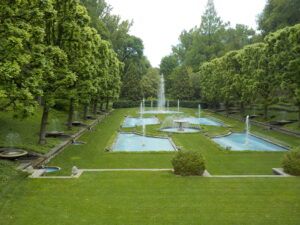
Formal use of lawns and water at Longwood
All three of the gardens I visited made much use of water in the landscape. I am lucky enough to have a small stream that runs by my gardens. I built a bench near it, so I can listen to the burble of the water. And you can tune your brook: Place stones that hold back water, allowing it to cascade over them. Different drops create different sounds.
Years ago, for NY Times article, I interviewed by phone the designer of the gardens at the Getty Museum in Los Angeles, Robert Irwin. He created a recirculating stream that crossed a path through a woodland area seven times. He told me he tuned it so that at each little bridge visitors would hear a different aquatic tune. Think of that if you have a stream on your property.
Color is very important in designing good or great gardens. I only got the 8-color box of crayons as a boy; my sister Ruth Anne got the 64-crayon box. But I have learned to appreciate all the nuances of color and how they go together. The best explanation of how colors go together – or don’t – is a book by garden writer Sydney Eddison: “The Gardener’s Palette: Creating Color in the Garden” (Contemporary Books, 2003, $30 in hardback). Get it if you can find a copy.
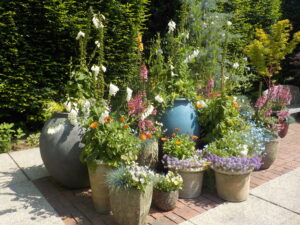
Pots at Longwood
Great gardens like those at Longwood, an old DuPont family residence originally, recognize that color is important all year. But most shrubs and perennials only bloom for a few weeks. So they choose trees and shrubs that are not only sculptural in form, but have also have nuanced colors in their leaves. Green is not one color, but many. Choose wisely.
Lastly, another way to present color all spring, summer and fall is to use annual flowers liberally. Many of these will keep on blooming in an effort to create seeds. Pots of annual flowers are used frequently in these great gardens. Pots place flowers closer to the viewer’s eye and can also be replaced with other pots if the flowers finish their displays or look a bit bedraggled.
So do visit other gardens this summer – whether at a local garden club tour or one of the fine gardens I mentioned here today.
Henry is a garden consultant and the author of 4 gardening books. He speaks often to garden clubs and library groups. Reach him at
henry.homeyer@comcast.net or PO Box 364, Cornish Flat, NH 03746.
Bedrock Gardens in Lee, New Hampshire is Well Worth a Visit
Posted on Tuesday, August 17, 2021 · Leave a Comment
I recently visited Bedrock Garden in Lee, NH and came away feeling refreshed and enlightened. This 37-acre public garden was created on the premises of a 1700’s farm that was purchased in 1980 by artist and garden designer Jill Nooney and her husband, Bob Munger.
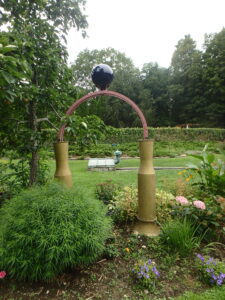
Gardens and sculpture go well together
Jill Nooney is a talented designer, who has won many awards at the Boston Flower Show. She is a welder who uses her skills to create metal sculptures from small to mammoth, as well as working with other media. Bob is a natural builder and fix-it guy who has enabled Jill to install her art in the landscape, along with water features, walls, paths and much more. They are a couple who really bring out the best in each other.
When I toured the gardens I was lucky to have had Jill as one of my guides. Also touring the gardens with me was John Forti, Executive Director and Horticulturist of the non-profit that manages the gardens. We spent nearly three hours together looking at the gardens and I learned about many plants I had never seen before.
Bedrock Garden is full of surprises that delight, enlighten and inspire visitors. I came away wishing I had a bigger garden space for my own efforts, and an appreciation for how much Jill and Bob have packed into their gardens.
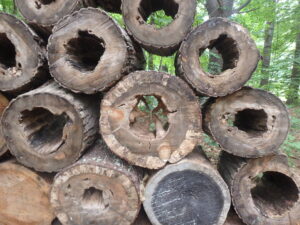
The Log Jam is something anyone could do
For years Bedrock Garden was open a few weekends each summer, but five years ago Jill and Bob decided that since they were approaching what some call “retirement age”, that they needed to look seriously at the future of the gardens. They created a non-profit, hired John Forti as the director, and figured out how to separate the public and private spaces.
During the pandemic they created a parking lot and visitors center that are accessed away from their home, the old farm house they have lived in for over 40 years. They have created a space that is family-friendly that delights children as much as their parents.
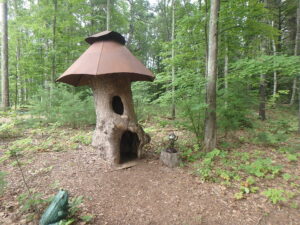
This gnome house near the parking area alerts children that they are welcome
Near the parking lot is a gnome house kids can enter made from a huge hollow sycamore log that Jill capped with a steel roof reminiscent of mushroom cap. She saw the wonderful hollow log alongside the road and hit her brakes immediately to ask for it. Luckily, she was the first to ask, and got it. (Five others stopped and asked for it that day, she told me, but she was the first).
I consider myself well exposed to the palette of plants available to gardeners in New Hampshire. Bedrock Garden is in Zone 5b, meaning that most years it does not get colder than minus 25 degrees Fahrenheit. But Jill has installed and grown many plants that I have never seen before, including many woody plants normally found in Japan or China.
Jill Nooney has used plants in ways that surprised me. So for example, she used ‘Bulls Blood’ heritage beets in a flower bed for their deep purple leaves. An annual effort, but very striking. When a hollow tree was cut down, she had Bob cut it in two-foot sections and stack the sections between two trees so viewers walking by could see through it like binoculars. One can see where branches had been swallowed by its growth. They call it “Log Jam.”
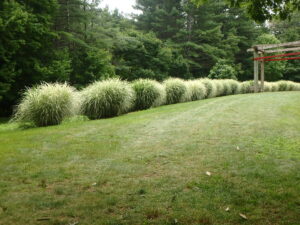
Decorative Miscanthus grass makes a statement in full sun
Jill has used decorative grasses well throughout the garden. Fountain grass (Miscanthus spp.) is a genus of grass that gets to be more than six feet tall and very bushy in full sun, where she grows it in an “allee” arrangement that is gorgeous. But she also uses it in shade. “It’s wispy in the shade”, she said,” I like that.”
Metal sculpture is a key element throughout the garden. Early in our tour I admired a space made by forming ¾-inch steel rebar into a series of 11 arches 13-feet tall and spaced 7 feet apart. “I’m using the sky,” she said. She consciously mimicked the lines of a Gothic cathedral, bending each steel frame to a gracefully pointed Gothic arch. And she is growing European fastigate beeches to clothe the metal frame as part of the installation: one on each side of the archways and tied to the steel. They will eventually reach the sky – the apex of the arch.
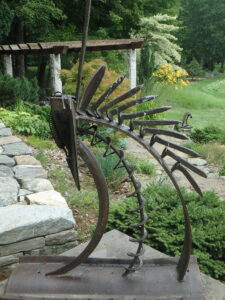
A steel chiwara or stylized antelope mask in the garden
Also in the garden are two iron “Chiwaras” modeled after antelope masks made by the Bambara people of Mali. Many years ago I had told Jill the legend of the antelope in Mali, where I had worked with the Peace Corps. The Bambara people credit the antelope for teaching them to plant millet, their primary grain. The antelope pawed the ground, and dropped a little manure into the soil containing seeds. So they honored the antelope with their stylized masks, which Jill captured beautifully.
So plan a visit to Bedrock
Garden if you can. There is a guided tour each day, and two on weekend days. Or just wander around and study the design elements – see how Jill has used plants that awe and inspire, and how she has added whimsy and art that delights and amuses. This is a
garden worth visiting even if you don’t have a big space or the energy to develop it the way Jill and Bob have. Bring a lunch and plan on spending the day. You’ll be glad you did. And if you have children in your life, think about attending the Fairy Hobbit House Festival October 9 to 11. Learn more at
www.bedrockgardens.org.
You may write Henry at PO Box 364, Cornish Flat, NH 03746, or e-mail him at
henry.homeyer@comcast.net. Please include a SASE if you want a response by mail.











